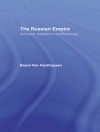Beginning in the 1870s, migrant groups from Russia’s steppes settled in the similar environment of the Great Plains. Many were Mennonites. They brought plants, in particular grain and fodder crops, trees and shrubs, as well as weeds. Following their example, and drawing on the expertise of emigre Russian-Jewish scientists, the US Department of Agriculture introduced more plants, agricultural sciences, especially soil science; and methods of planting trees to shelter the land from the wind. By the 1930s, many of the grain varieties in the Great Plains had been imported from the steppes. The fertile soil was classified using the Russian term ‘chernozem’. The US Forest Service was planting shelterbelts using techniques pioneered in the steppes. And, tumbling across the plains was an invasive weed from the steppes: tumbleweed. Based on archival research in the United States, Russia, Ukraine, and Kazakhstan, this book explores the unexpected Russian roots of Great Plains agriculture.
David Moon
American Steppes [EPUB ebook]
The Unexpected Russian Roots of Great Plains Agriculture, 1870s-1930s
American Steppes [EPUB ebook]
The Unexpected Russian Roots of Great Plains Agriculture, 1870s-1930s
Cumpărați această carte electronică și primiți încă 1 GRATUIT!
Limba Engleză ● Format EPUB ● ISBN 9781108882866 ● Editura Cambridge University Press ● Publicat 2020 ● Descărcabil 3 ori ● Valută EUR ● ID 7412598 ● Protecție împotriva copiilor Adobe DRM
Necesită un cititor de ebook capabil de DRM












